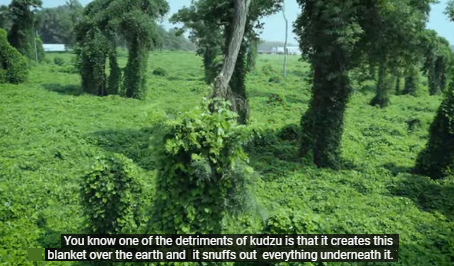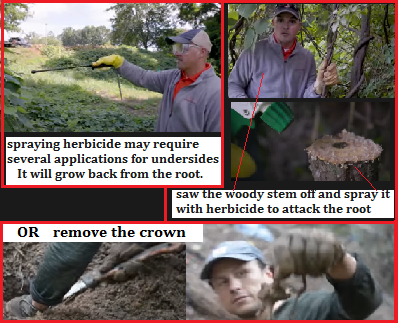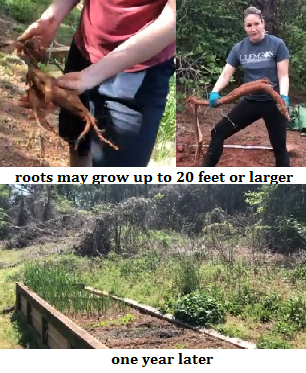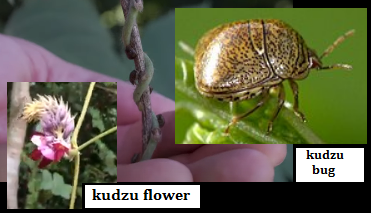Essays Contents
Invasive Kudzu
November 5, 2023

The Kudzu
wikipedia


Kudzu Identification, History, and Control
"FNRClemson" channel
If you spray... lower leaves of kudzu are protected by upper leaves
requiring several applications of herbicide... but this does not even
kill the plant. To kill kudzu you must remove the root's crown...
OR...
cut the main stalk and apply herbicide to the opened vine...
or mow repeatedly to starve the root of nourishment.
Some say you must remove the root nodes AND the root.
How to Get Rid of Kudzu
"Conserving Carolina" channel
A volunteer crew digs up kudzu for two hours on Mondays.
Did we just discover a remedy for the homeless population...?
Give them a spade and a small saw...?


HOW TO REMOVE AND CONTROL KUDZU
"Auxhart Gardening" channel

Cleaning up Kudzu
"Upstate Brush Control" channel
Using big machinery to clear an acreage

South Georgia Student Develops Method To Control Kudzu
"Farm Monitor" channel
Jacob rigged a tool to inject helium into the soil, which kills kudzu.

follow up 6 years later Jacob is still working at the kudzu
UGA Student Seeks To Tame Kudzu’s Rapid Growth
Jacob Schindler, "The Kudzu Kid,"
says it's always been about controlling kudzu...
knowing how hard it will be to actually eliminate kudzu.
He was given a patent for his helium injecting device in 2014.
He says that kudzu has potential as forage material
for livestock... or as biomass for energy production.
"Once you control it... then you can utilize it for its benefits."


Goats Take On Kudzu in Historic Railroad Town
"Environment Matters" channel
The National Park Service is using the services of two dozen goats to tackle the problem of invasive plant species taking over the town of Thurmond in the New River Gorge National River.
It is too steep for work crews.
"Green Goats" provides goats for eradication projects of invasive species.
Goats that were old or abandoned are used to forage invasive plants.
Larry Cihanec says, "We're giving them a purpose.
They live the American dream... they eat for a living."


Kudzu and the Kudzu Bug
"SouthCarolinaETV" channel
The Kudzu plant was introduced to the United States to control erosion in the late 19th century. Unfortunately, it got out of hand and it is now referred to as the “vine that ate the South.” During the Summer months in South Carolina, Kudzu can grow up to a foot long in a day.
The Kudzu Bug species is truly invasive as well, most likely
originating from Japan or China based on genetic evidence.
A likely scenario is that one gravid female made it on board an
international flight from the Far East straight to the USA
(most likely Atlanta, GA), got out of the airplane in Atlanta,
and started colonizing patches of Kudzu east of the Atlanta area.
There were 9 counties in northeast GA that had confirmed findings
of Kudzu Bug in 2009. By 2010, South Carolina had the insect in
16 counties. By May of 2011, South Carolina became the first state
to be totally infested with the species.
Now, the species covers the entire southeastern USA.
Kudzu Bug also “likes” light colors, such as the white trim used on houses, and it congregates on homes and is a tremendous nuisance pest.
Dr. Jeremy Greene and his colleague Dr. Francis Reay-Jones worked with a couple of graduate students on the Kudzu Bug as it related to soybean production. They generated more than a dozen scientific papers on the pest in soybeans. Kudzu Bugs wreaked havoc on soybean producers and home owners for years, primarily between 2010 and 2015. Then, they began to notice a sudden decline in their numbers.
One of the things they discovered is a naturally occurring fungal organism that lives in our soil infects the Kudzu Bug. This entomopathogen called Beauveria bassiana attacks insects, but a strain was selected that recognized Kudzu Bugs so well, it actually caused a significant decline in numbers of the species. There is also a small wasp that specifically attacks the eggs of the Kudzu Bug. Both of these natural enemies have exerted tremendous biological control on the Kudzu Bugs.
Dr. Greene ends this report by saying, "Kudzu is here to stay. I don't know of any program that can effectively eradicate it from the United States."
wikipedia


Kudzu Identification, History, and Control
"FNRClemson" channel
If you spray... lower leaves of kudzu are protected by upper leaves
requiring several applications of herbicide... but this does not even
kill the plant. To kill kudzu you must remove the root's crown... OR...
cut the main stalk and apply herbicide to the opened vine...
or mow repeatedly to starve the root of nourishment.
Some say you must remove the root nodes AND the root.
How to Get Rid of Kudzu
"Conserving Carolina" channel
A volunteer crew digs up kudzu for two hours on Mondays.
Did we just discover a remedy for the homeless population...?
Give them a spade and a small saw...?


HOW TO REMOVE AND CONTROL KUDZU
"Auxhart Gardening" channel

Cleaning up Kudzu
"Upstate Brush Control" channel
Using big machinery to clear an acreage

South Georgia Student Develops Method To Control Kudzu
"Farm Monitor" channel
Jacob rigged a tool to inject helium into the soil, which kills kudzu.

follow up 6 years later Jacob is still working at the kudzu
UGA Student Seeks To Tame Kudzu’s Rapid Growth
Jacob Schindler, "The Kudzu Kid,"
says it's always been about controlling kudzu...
knowing how hard it will be to actually eliminate kudzu.
He was given a patent for his helium injecting device in 2014.
He says that kudzu has potential as forage material
for livestock... or as biomass for energy production.
"Once you control it... then you can utilize it for its benefits."


Goats Take On Kudzu in Historic Railroad Town
"Environment Matters" channel
The National Park Service is using the services of two dozen goats to tackle the problem of invasive plant species taking over the town of Thurmond in the New River Gorge National River.
It is too steep for work crews.
"Green Goats" provides goats for eradication projects of invasive species.
Goats that were old or abandoned are used to forage invasive plants.
Larry Cihanec says, "We're giving them a purpose.
They live the American dream... they eat for a living."


Kudzu and the Kudzu Bug
"SouthCarolinaETV" channel
The Kudzu plant was introduced to the United States to control erosion in the late 19th century. Unfortunately, it got out of hand and it is now referred to as the “vine that ate the South.” During the Summer months in South Carolina, Kudzu can grow up to a foot long in a day.
The Kudzu Bug species is truly invasive as well, most likely
originating from Japan or China based on genetic evidence.
A likely scenario is that one gravid female made it on board an
international flight from the Far East straight to the USA
(most likely Atlanta, GA), got out of the airplane in Atlanta,
and started colonizing patches of Kudzu east of the Atlanta area.
There were 9 counties in northeast GA that had confirmed findings
of Kudzu Bug in 2009. By 2010, South Carolina had the insect in
16 counties. By May of 2011, South Carolina became the first state
to be totally infested with the species.
Now, the species covers the entire southeastern USA.
Kudzu Bug also “likes” light colors, such as the white trim used on houses, and it congregates on homes and is a tremendous nuisance pest.
Dr. Jeremy Greene and his colleague Dr. Francis Reay-Jones worked with a couple of graduate students on the Kudzu Bug as it related to soybean production. They generated more than a dozen scientific papers on the pest in soybeans. Kudzu Bugs wreaked havoc on soybean producers and home owners for years, primarily between 2010 and 2015. Then, they began to notice a sudden decline in their numbers.
One of the things they discovered is a naturally occurring fungal organism that lives in our soil infects the Kudzu Bug. This entomopathogen called Beauveria bassiana attacks insects, but a strain was selected that recognized Kudzu Bugs so well, it actually caused a significant decline in numbers of the species. There is also a small wasp that specifically attacks the eggs of the Kudzu Bug. Both of these natural enemies have exerted tremendous biological control on the Kudzu Bugs.
Dr. Greene ends this report by saying, "Kudzu is here to stay. I don't know of any program that can effectively eradicate it from the United States."

